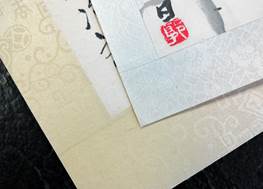 Photo 1
Photo 1
Left has front mounted strips, right has back mounted. Chinese kozo art backed and edged over 60 years ago.
The term scroll mount in the western world is generally thought of as an Asian painting that has been starch mounted to a flexible support backing—called a scroll—allowing for it to be rolled and stored when not on display. Asian ink and watercolor paintings, stone rubbings, silk embroidery, and batik are traditionally backed and mounted as scrolls in country, though contemporary trends also offer them as framed art. There is little understanding of preservation, and paper edged art is usually pressed directly against glass, if glazed at all. Since scrolls are rarely under glass it is a perfectly acceptable practice for them not to glaze a western window matted image either.
In the western world we have a higher appreciation of protection when it comes to art for display, but learning about framing in the Far East helps us become more educated about international framing practices.
Edged Mounts
Wet mounting a sheet of kozo paper as a support backing is completed by the artist—as part of the process—and is a requirement prior to creating a scroll or placing art in a frame. Starch backing is the only way to flatten water soaked mulberry paper that has cockled or been folded. It also strengthens the paper by doubling its thickness, and intensifies the painted inks and colors.
 Photo 1
Photo 1
Left has front mounted strips, right has back mounted. Chinese kozo art backed and edged over 60 years ago.
Edged mounts are Asian versions of western window mats made by wet mounting strips of paper-backed silk to original art. Decorative trim edging is starch pasted by overlapping outer ⅛" edges of the painting all around the perimeter using solid or patterned papers or silk fabrics. (photo 1) Strips are applied to the outer edge of either the art face or the back edge, but only when the art has previously been backed. (photo 2)
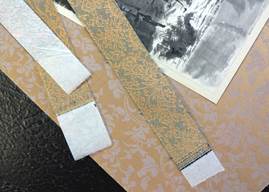 Photo 2
Photo 2
Original painting has been paper backed by the artist with starch paste. Silk has been starch pasted with kozo backing for support and handling, shown front and back.
The application of these strips surrounding a kozo backed painting is designed to help protect the edges of the original art when handled, and the contrasting color of the edging brocade is selected as a visual accent and enhancement, just as our window mat would be.
Paper Backed Materials
Commercial paper backed brocade is available from an assortment of stores on the internet and Asian art supply houses, often sold for bookbinding, fine crafts, mounting and edging painted art. Sheets are often imported from China and Japan with patterns based on classic fabrics and motifs. Paper backed brocade is sold by the sheet and by the yard, from assorted American importers of art and sumi supplies, but may easily run $50 to $75 per sheet and paper backed brocade book cloth can run over $100 per yard if purchased in the USA.
In recent years traditional techniques have been simplified by the introduction of iron-on silk brocade, sold by the yard, again from specialty Asian art suppliers. It is pre-backed with heat-activated adhesive film which activates between 180ºF and 200ºF in 15 seconds. I have not tested it personally so I do not know if it is a permanent adhesive which bonds in the press as it reaches temperature, or removable which bonds as it cools under weight. It is promoted for artists as bonding with a standard household iron using set slightly below wool.
Bamboo and gampi decorative papers are also occasionally used for solids, while patterned block prints, screen prints, and hand painted papers are used for patterns. These papers may be dyed rather than pigmented so selected papers should be tested for lightfastness prior to use.
Unbacked Silks
Japanese decorative papers and printed cotton fabrics are often used as an accent strip—as would be used above and below the art on a traditional scroll—since bold patterns are often too overwhelming for surrounding all of the art. The most common visually softer fabrics used for scrolls are silk gauze, plain woven silk, patterned brocade, raw silk, and satin. (photo 3)
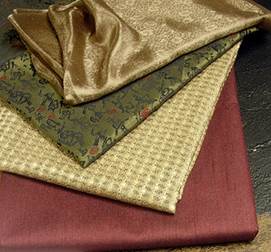 Photo 3
Photo 3
Fabric yardage from top is sheer silk gauze, woven patterned silk, mid weight brocade, and raw silk.
Unbacked fabric brocade, raw, and sheer silk yardage must be hand mounted with kozo paper backing prior to use for edging or rigid scroll mounts. The paper gives it support making it easier to size and mount. See The Mounting And Laminating Handbook, 3rd Edition, Kozo Backing and Contemporary Scroll Mount, pgs 48-50 for additional information.
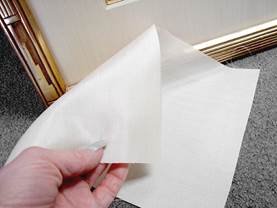 Photo 4
Photo 4
Sheer silk is nearly translucent and could bleed through when adhered with white glue.
Wet-Dry Mounting
Sheer silk is translucent and could easily bleed through when adhered with a commercial white glue rather than thicker starch paste so a wet-dry method is recommended with sheers, even when only backing. (photo 4)—The application uses a soft sponge roller to evenly apply the adhesive first vertically then horizontally to the solid substrate, allowing each layer to fully dry before proceeding. (photo 5) Then the sheer fabric is aligned, smoothed, tacked to the paper, and then mounted in a preheated press at 180ºF. The approximate time is 1-2 minutes in mechanical press and 4 minutes in hot vacuum press, depending on the press manufacturer.
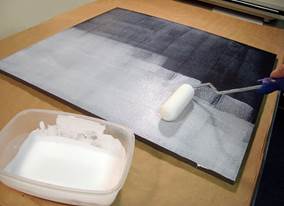 Photo 5
Photo 5
The photo is demonstrating the application technique using a soft sponge roller on a dark foamboard for illustration.
Rigid Scroll
The mounting of Asian art with starch paste onto a ½" acid free, foamcenter board, then surrounding it with paper backed brocade fabric creates an alternative presentation as a contemporary scroll design, known as a rigid scroll mount or contemporary brocade mount. Since the finished art is rigid and framed, the brocade resembles an edge mount matted painting while still holding the traditional appearance of a paper scroll. It remains unglazed as a scroll would be, but could have glazing applied if a spacer was added. (photo 6)
 Photo 6
Photo 6
"Every Day is a Good Day" is framed in an 8x30" green bamboo profile #8109274 from Max Moulding. Calligraphy shown compliments of Chris A. Paschke.
Layout and Execution
A sheet of ½" foam center board is preferred as the substrate for a rigid scroll being thick enough allowing for the option of being left unframed or framed. A ³⁄₁₆" sheet is simply too thin to pass as an unframed gallery wrap and the thinner support will not give adequate rigidity for the wet-dry mounting and added surface stresses. Though more rigid products like Bienfang MightyCore or Gatorboard might not warp they still do not have the width to stand alone.
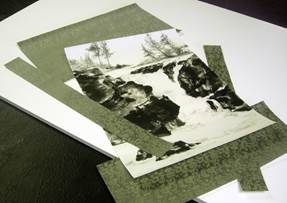 Photo 7
Photo 7
All pieces sized for this rigid scroll mount are cut for a frame and not a gallery wrap on ½" foamboard.
For an unframed rigid mount the silk brocade will be glued to the surface of the foamboard then wrapped around the ½" edge of the foam to the back. Allowances need to be made for fabric for that wrap. If it is known the brocade mat is to be placed in a frame this extra fabric is not necessary.
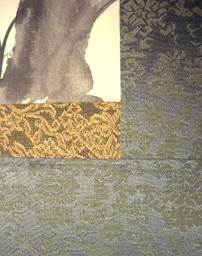 Photo 8
Photo 8
All strips are evenly overlapped ⅛", and seams are always a visible part of the design.
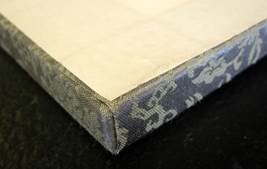 Photo 9
Photo 9
A full sheet of kozo paper backing is pasted entirely to the back.
The folded and wrapped back flaps must be covered with a final full sheet of kozo to protect the edges from lifting or the fabric from fraying, and to give it a finished appearance. (photo 9) Unlike the western tradition of a dust cover only glued or taped at the outer edges, the Asian way is to mount the entire back with a final sheet of heavier kozo for support as was done on this project. This is also done with rolled scrolls. No additional dust cover would be used for this.
END
Copyright © 2018 Chris A Paschke
Resources—Items
http://franksfabrics.com/—Franks Fabric Adhesive
https://blueheronarts.com/—Iron-on paper backed silk
http://iyuemei.com/—Brocade paper
https://fineartstore.com/—Chinese brocade paper sheets
For more articles on mounting basics look under the mounting section in Articles by Subject.
Additional information on all types of mounting is found in:
The Mounting and Laminating Handbook, Second Edition, 2002,
The Mounting And Laminating Handbook, Third Edition, 2008 and
Creative Mounting, Wrapping, And Laminating, 2000 will teach you everything you need to know about getting the most from your dry mount equipment and materials as an innovative frame designer.
All books are available from Designs Ink Publishing through this website.
Chris A Paschke, CPF GCF
Designs Ink
Designs Ink Publishing
785 Tucker Road, Suite G-183
Tehachapi, CA 93561
P 661-821-2188
chris@designsinkart.com